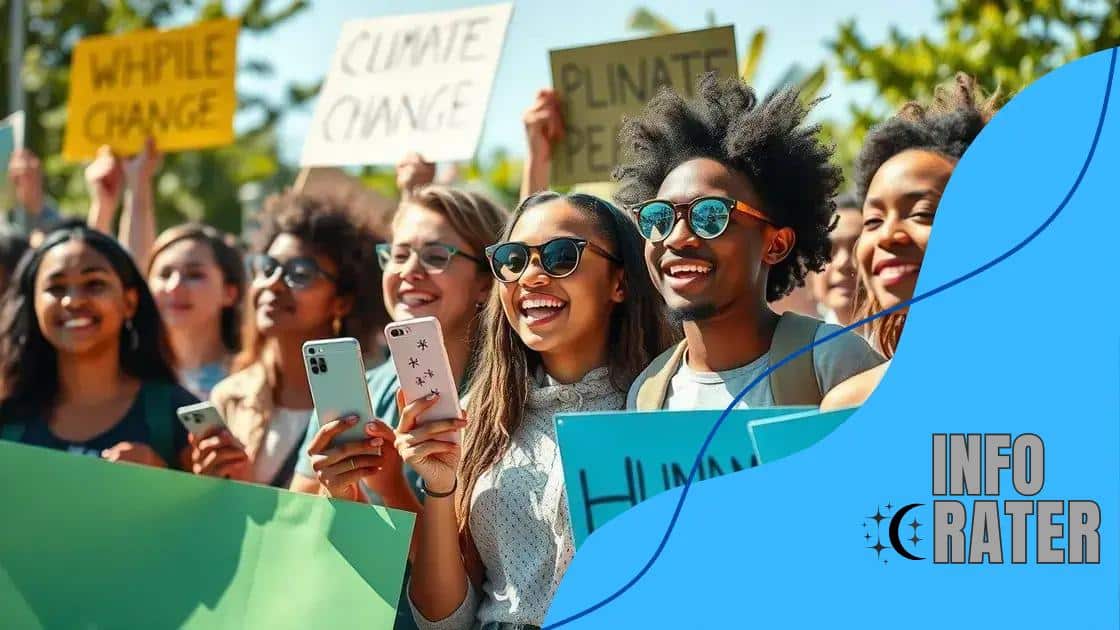Social media’s role in global climate advocacy

Social media plays a crucial role in global climate advocacy by enhancing awareness, mobilizing communities, and enabling diverse engagements, while also presenting challenges like misinformation and online harassment.
Social media’s role in global climate advocacy has become increasingly vital. It’s fascinating to see how platforms like Twitter and Instagram are shaping discussions and mobilizing action toward climate change. How can individuals leverage this power for greater impact?
The impact of social media on public perception of climate change
Social media plays a vital role in shaping public perception of climate change. Many people turn to platforms like Facebook and Instagram for information, discussions, and inspiration related to environmental issues. As a result, the content shared on these platforms can influence how the public views climate action and its urgency.
The Power of Virality
One of the most significant impacts of social media is its ability to make information go viral.
- Viral posts can reach millions quickly.
- They often highlight urgent climate issues or advocate for immediate action.
- Engagement through likes, shares, and comments amplifies the message.
This rapid dissemination can lead people to become more aware of the challenges posed by climate change. It also drives conversations in ways that traditional media might not. For instance, grassroots movements often gain momentum on social media, allowing individuals to mobilize around shared goals.
Engaging Younger Audiences
Moreover, social media effectively engages younger generations. Many young people use these platforms daily. They find communities that share their values and concerns about climate change. This creates a sense of belonging and empowerment. Campaigns like Fridays for Future and various hashtag movements exemplify how social media fosters collective action.
As conversations about climate change expand, social media also allows for diverse voices to be heard. Many activists share personal stories that resonate emotionally with others. This personal touch can encourage people to take action, be it through signing petitions, attending demonstrations, or altering their lifestyles.
Challenges and Misinformation
Despite its benefits, social media is not without challenges. A significant problem is the spread of misinformation. Many users are exposed to misleading or false information, which can shape their beliefs about climate change negatively.
- Understanding the differences between credible sources and misinformation is crucial.
- Fact-checking organizations provide resources for users to discern the validity of claims.
- Encouraging critical thinking can help combat the spread of false narratives.
In conclusion, social media’s influence on the public perception of climate change is undeniable. It shapes conversations, promotes awareness, and mobilizes action. However, addressing the challenges that come with misinformation is essential to harness this power effectively.
How platforms facilitate global climate movements
Social media platforms are essential for mobilizing global climate movements. They serve as powerful tools for raising awareness, organizing events, and spreading vital information. Platforms like Twitter, Facebook, and Instagram allow users to connect and share ideas quickly.
Creating Awareness
One significant way these platforms facilitate climate movements is through awareness campaigns. Hashtags like #ClimateStrike and #FridaysForFuture help gather support and spread messages. Users can share posts that highlight urgent climate issues. This creates a ripple effect as more people engage with the content.
- Influencers amplify the message to larger audiences.
- Users can share their personal stories to resonate with others.
- Visual content, like videos and infographics, captures attention quickly.
Such engagement encourages more individuals to learn about climate change and advocate for action. As discussions spread, they inspire collective movements, pulling in participants from various backgrounds.
Mobilizing Action
In addition to awareness, social media platforms serve as organizing hubs for activism. Groups can quickly coordinate rallies, protests, and informational events. Through events created on these platforms, users can RSVP and invite friends, creating a sense of community.
Even small local actions can gain international visibility, which is essential for broader movements. The power of community is amplified as individuals **connect** over shared goals. Many activists use live streams and stories to document their experiences, engaging their followers in real-time.
By utilizing social media, movements can gather momentum and mobilize support both locally and globally. These platforms enable advocates to share resources and collaborate across distances.
Engaging Diverse Audiences
Furthermore, social media platforms engage diverse audiences. They provide a space for voices that have traditionally been marginalized in environmental discussions. Young people are especially active on these platforms, bringing fresh perspectives and innovative ideas.
- Diverse perspectives enrich the climate conversation.
- Young activists often lead the charge advocating for change.
- Different cultures bring unique approaches to sustainability.
As these platforms continue to evolve, they will likely play an even more critical role in the future of climate movements. Engaging and empowering a global audience can lead to significant change across nations.
Case studies of successful social media campaigns

There are numerous examples of successful social media campaigns that highlight the power of engaging the public in climate advocacy. These campaigns have effectively mobilized people and driven significant action. Understanding these case studies can shed light on best practices for future movements.
1. #FridaysForFuture
This global movement started with Greta Thunberg, a young activist who began protesting outside the Swedish Parliament. The simplicity of her message quickly resonated online, leading to weekly climate strikes worldwide. The hashtag #FridaysForFuture spread swiftly, connecting students and activists across the globe.
- These strikes inspired millions of young people to take action.
- Social media helped organize events and share experiences.
- Powerful visuals and stories drew media attention.
This campaign illustrates how one person’s actions can spark a global movement through social media.
2. #MeToo
While primarily associated with women’s rights, the #MeToo movement also significantly impacted environmental advocacy. Activists used this platform to highlight the intersectionality between gender and climate issues. Various campaigns showed how marginalized communities are disproportionately affected by climate change.
- It raised awareness about justice and equity in climate discussions.
- Brave individuals shared their stories to promote change.
- This approach encouraged solidarity and coalition-building across different movements.
The integration of such critical social issues demonstrates how social media can expand the dialogue around climate advocacy.
3. The Ice Bucket Challenge
Though specific to ALS awareness, the Ice Bucket Challenge is a prime example of how viral social media campaigns can attract attention for a cause. It started as a fun challenge among friends but quickly escalated into a global phenomenon.
Participants donated and challenged others, raising millions for ALS research. This campaign showcased how engaging and interactive content can drive donations and awareness. The combination of light-hearted participation and serious underlying issues can create substantial impacts. It emphasized that even entertaining challenges could lead to serious discussions around health and environmental concerns.
Challenges faced by climate advocates on social media
Climate advocates often encounter various challenges when using social media to promote their messages. Although the platforms provide significant opportunities for outreach and engagement, they also present obstacles that can hinder effective communication. Understanding these challenges is crucial for advocates seeking to maximize their impact.
Misinformation and Disinformation
One of the major hurdles is the prevalence of misinformation about climate change. False information can easily spread through social media, confusing the public and undermining credible science.
- Some users share misleading articles without fact-checking.
- Climate change denial can gain traction and create doubt.
- Counteracting misinformation requires time and effort from advocates.
This can divert attention from urgent calls for action, making it difficult to engage meaningfully with audiences who may be misinformed.
Online Harassment
Another significant challenge is the risk of online harassment. Many climate advocates, especially young women and marginalized individuals, experience targeted attacks.
- Harassment can deter people from expressing their views.
- It creates a toxic environment that discourages participation.
- Some advocates may choose to silence themselves due to fear.
Such behavior not only impacts individual advocates but also affects the overall movement by suppressing diverse voices and viewpoints.
Algorithm Limitations
Social media algorithms often favor sensational content over informative posts. As a result, important climate messages may struggle to reach wider audiences.
Advocates must constantly adapt their strategies to work within these algorithms, which can be frustrating and resource-intensive. It is essential to create engaging content that stands out in crowded feeds while still conveying serious messages.
Moreover, algorithms can inadvertently create echo chambers, limiting discussions to like-minded individuals and excluding those who may benefit from different perspectives.
Division Among Advocates
Lastly, division among climate advocates often poses a challenge. Different factions may prioritize various issues, leading to fragmentation rather than unity.
- Disputes over tactics can weaken collaborative efforts.
- Inclusive discussions can be overshadowed by disagreements.
- Finding common ground is essential for progress.
Understanding and addressing these challenges can help climate advocates use social media more effectively to communicate their messages and unite for meaningful change.
Future of climate advocacy through digital engagement
The future of climate advocacy is increasingly intertwined with digital engagement. As technology evolves, climate advocates must adapt to new tools and platforms to reach wider audiences effectively. This shift allows for innovative approaches to educate and mobilize people toward climate action.
Emergence of New Platforms
Emerging platforms like TikTok and Clubhouse are changing the landscape for climate discourse. These platforms facilitate real-time discussions and creative content sharing.
- TikTok, with its short videos, allows for digestible climate information.
- Clubhouse enables live conversations where experts and communities can interact.
- These platforms attract younger audiences who are passionate about climate issues.
The ability to connect and communicate in real-time encourages more people to participate in climate advocacy.
Data-Driven Strategies
In the future, using data-driven strategies will play a pivotal role. Advocates can leverage analytics to understand their audience better. By analyzing engagement metrics, climate advocates can tailor their content more effectively.
- Social media analytics help identify which messages resonate best.
- Data can inform targeted campaigns to reach specific demographics.
- Understanding trends can guide future advocacy efforts.
This data-driven approach enhances the ability to connect with supporters and encourages sustained involvement.
Building Online Communities
Digital engagement also fosters the creation of online communities. Advocacy groups can now create networks to unite individuals who share common goals. These communities offer support and resources for members interested in climate action.
Through forums, social media groups, and online events, advocates can share ideas and collaborate. Such collaboration can result in collective movements that drive substantial change.
Utilizing Interactive Content
Moreover, the use of interactive content is crucial for future advocacy. Quizzes, polls, and infographics can help engage the audience meaningfully. By creating a participative experience, advocates can educate and inspire action more effectively.
- Interactive content can simplify complex information about climate science.
- Gamification can encourage users to take part in sustainability challenges.
- Engagement through interactive formats increases retention of information.
The evolution of technology offers numerous opportunities for innovative climate advocacy. Embracing these changes empowers advocates to reach broader audiences and inspire substantive actions for the environment.
FAQ – Frequently Asked Questions about Climate Advocacy and Digital Engagement
How can social media enhance climate advocacy?
Social media allows advocates to spread awareness, mobilize communities, and engage diverse audiences in real-time discussions about climate issues.
What challenges do climate advocates face on digital platforms?
Challenges include misinformation, online harassment, algorithm limitations, and divisions among advocates, which can hinder effective communication.
What role do data-driven strategies play in climate advocacy?
Data-driven strategies help advocates understand audience preferences, tailor content effectively, and improve engagement on digital platforms.
How can interactive content support climate advocacy efforts?
Interactive content, such as quizzes and polls, engages audiences meaningfully and makes complex climate information more accessible.





